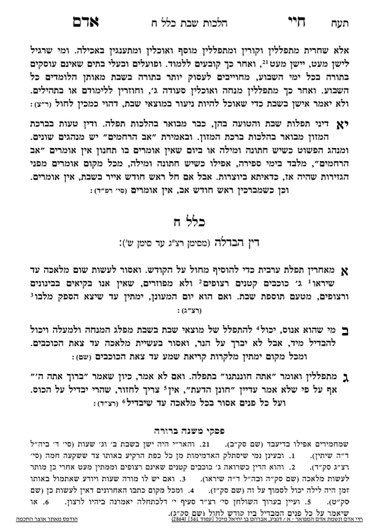The current series is available for sponsorship. Please contact Rabbi Reingold for more information.
We are beginning Klal 8, which discusses maariv on motzai Shabbos and havdalah. The Chayei Adam writes that in the same way there is a concept of tosefes Shabbos when going into Shabbos, there is a concept of tosefes Shabbos when leaving Shabbos as well. Therefore, even though a person could theoretically begin maariv at tzeis hakochavim, it is appropriate to wait a little longer before beginning. (We will see in the next siman that theoretically, a person can daven maariv on Shabbos itself, but it is only to be relied upon when a person has no other choice.)
Included in the concept of tosefes Shabbos on motzai Shabbos is the issur to perform melacha until one waits for tosefes Shabbos.
The Chayei Adam writes that the amount of time one should wait on motzai Shabbos before beginning melacha is until tzeis hakochavim of three small stars which can be seen in close proximity to each other.
In truth, the primary zman for tzeis hakochavim is three medium stars. As the light fades at sunset, the brightest stars are visible first. Next, the medium size stars become visible, and eventually, even small stars, which give relatively little light, become visible. The primary zman for tzeis hakochavim is three medium stars. However, we are not longer experts in identifying medium stars, so we wait for three small stars, out of safeik. Since we wait for three small stars out of safeik, it cannot be counted as tosefes Shabbos. Therefore, the tosefes Shabbos is that even though the small stars we wait for generally can be seen throughout the sky, after Shabbos, we wait until they are seen near each other in the sky, which requires more light to fade.
The Chayei Adam explains that we wait for three small stars, because, as we learned, we are no longer experts in identifying medium stars. Another way to understand the requirement for small stars is that without small stars, it is impossible to identify a medium star, because we do not yet have a comparison. The need for proximity is because of tosefes Shabbos.
The Mishnah Berurah points out that if a person has a clock, and the previous night was able to clearly see the stars, and noticed the time, they can rely on the clock the next night if the stars are not visible due to cloudiness.
The fact is that we have difficulty visualizing the stars nowadays, due to light pollution. Therefore, we rely on information given to us which tells us when the sun has gone below the horizon a certain amount, which, in turn, tells us that stars should be visible. We see from the Chayei Adam that historically, tzeis hakochavim and other zemanim were visualized. In fact, even in Eretz Yisroel, the Chazon Ish would pasken motzai Shabbos based on sighting the stars.
Summary
-Tosefes Shabbos applies to motzai Shabbos as well. We wait until the appearance of three small stars which are visible in close proximity to each other.
– Tosefes Shabbos can be fulfilled by refraining from melacha. We are machmir to not start maariv until after tosefes Shabbos.
– Meikar hadin, tzais hachochavim requires three medium stars to be visible. Three small stars are due to the fact that we are not experts in defining what is medium.
– The requirement of proximity is to fulfill tosefes Shabbos.
– When visualization is not possible, one can rely on a clock.



